Products
DJI Mavic 2 Zoom v DJI Mavic 2 Enterprise v DJI Mavic 2 Enterprise Dual
An in-depth look at which drone is better - the DJI Mavic 2 Zoom, Mavic 2 Enterprise or the Mavic 2 Enterprise Dual ... Read More

2018 was a busy and productive year for the Mavic Series of drones, with DJI unveiling no fewer than five iterations.
The year began with the release of the Mavic Air, then the Mavic 2 Zoom and Pro in the summer, followed by the Mavic 2 Enterprise in the autumn, before closing 2018 with the Mavic 2 Enterprise Dual.
In their own right, each drone within this Mavic quintet has its own quirks and uses, but this particular blog post focuses on the Mavic 2 Zoom, Mavic 2 Enterprise and the Mavic 2 Enterprise Dual, as they are very similar in nature, but also have some major differences.
Mavic-2-zoom-1-700x700.jpg
DJI Mavic 2 Zoom
IMG_5168-700x467.jpg
DJI Mavic 2 Enterprise
Mavic-2-Ent-Dual-AircraftSpotlight-2-700x394.png
DJI Mavic 2 Enterprise Dual
Price comparison between Mavic 2 Zoom, Mavic 2 Enterprise and Mavic 2 Enterprise Dual
One of the key questions is how much will each of these drones cost? And there is a difference.
The Mavic 2 Zoom is priced £1,099, which includes a remote controller, intelligent flight battery, three propellers set (x2) and a charger.

Mavic 2 Zoom - in the box
To take your flights further, the Fly More Kit is available for an additional £339, which features two batteries, a car charger, battery charging hub, a battery to power bank adapter, two low-noise propellers (pair) and a Mavic 2 shoulder bag.
The Mavic 2 Enterprise versions are more expensive, but still represent decent value for money, considering their purpose.
The Mavic 2 Enterprise Universal Edition is priced £2,069, while the Dual (Universal Edition) costs £2,669. Both come with a host of add-ons, including battery charger, power cable, three propellers (x2), spare control stick (pair), communication cable (USB3.0 Type-C), USB adapter, extended port cover, various RC cables, a protector case and the speaker, spotlight and beacon accessories.
Dual-universal-2-700x406.jpg
The Universal Editions of the Mavic 2 Enterprise and Mavic 2 Enterprise Dual
Just like the Mavic 2 Zoom, a Fly More pack is available for the Enterprise models, priced £399, and includes two self-heating batteries, a car charger, battery charging hub, battery to power bank adapter, 2x low-noise propeller pairs and a bag.
LOOK AND KEY SPECIFICATIONS
When it comes to the look of the three drones, it's safe to say that they are very much identical triplets - they are all foldable, light and portable quadcopters. Their similarities are striking when looking at their specifications.

Mavic 2 Zoom
Take-off weight: 905g
Dimensions: Folded: 214mm x 91mm x 84mm. Unfolded: 322mm x 242mm x 84mm
Diagonal length: 354mm
Max flight time: 31 mins
Max speed: 72kph

Mavic 2 Enterprise
Take-off weight: 905g (without accessories).
Dimensions: Folded: 214mm x 91mm x 84mm. Unfolded: 322mm x 242mm x 84mm
Diagonal length: 354mm
Max flight time: 31 mins
Max speed: 72kph

Mavic 2 Enterprise Dual
Take-off weight: 899g (without accessories)
Dimensions: Folded: 214mm x 91mm x 84mm. Unfolded: 322mm x 242mm x 84mm
Diagonal length: 354mm
Max flight time: 31 mins
Max speed: 72kph
In terms of flight safety, all three benefit from Omnidirectional Obstacle Sensing, with obstacle sensors on all sides of the aircraft for greater safety during flight.
They also have OcuSync 2.0, which supports automatic dual frequency band switching. This ensures a more reliable and stable flight, and enhanced video transmission of up to 8km at 1080p resolution.
However, only the Mavic 2 Enterprise and Mavic 2 Enterprise Dual come equipped with DJI’s AirSense technology, to help improve pilots’ situational awareness and enhance airspace safety.
In a nutshell, all three drones are very similar, but the Mavic 2 Enterprise and Dual are beefed-up versions of their predecessor. There are also some key factors which set these aircraft apart.
Target audience
One of the biggest differences between these three drones is the target audience - and a major clue is in the title.
The Mavic 2 Enterprise and Mavic 2 Enterprise Dual, are, as their names suggest, particularly suited for business and industry - ideal for the likes of utility inspections, public safety, inspection, search and rescue, fire response and law enforcement.

There are several features which place these two drones firmly into this category, especially the ability to attach three key payloads, namely a speaker, dual spotlight or a beacon.
Speaker
Mavic-2-Ent-Dual-AircraftSpeaker-21-2-700x394.png
spekaer-4-700x700.jpg
A loudspeaker with a maximum projection of 100 decibels (1-meter distance) lets pilots play up to 10 custom voice recordings on demand, providing a communications channel to nearby individuals that can be critical during life-saving emergency operations.
Spotlight
Mavic-2-Ent-Dual-AircraftSpotlight-1-3-700x394.png
Light-4-700x700.jpg
A dual spotlight with a brightness of 2,400 lumens aids operators in carrying out missions in dark or low-light areas. Spotlight is ideal for search and rescue as well as inspection applications.
Beacon
Mavic-2-Ent-Dual-AircraftBeacon-10-2-700x394.png
beacon-4-700x700.jpg
Designed with US Federal Aviation Administration Night Waiver standards in mind, the Beacon features a bright flashing strobe visible three miles away. This helps pilots carry out missions in low-light conditions or at night much more safely, and provides additional airspace awareness for operators of nearby drones and traditional aircraft.
The Mavic 2 Enterprise and Mavic 2 Enterprise Dual come with an array of other key features which make them ideal for enterprise, especially the emergency services. These include:
Password-protected data: Password is needed to take off or to access the 24GB on-board storage, ensuring that the data stays safe, even if the drone falls into the wrong hands.
GPS timestamping: GPS timestamping records the time and GPS coordinates of when and where images are taken.
Self-heating battery: Allows the drone to perform reliably in adverse weather conditions as low as -10 Celsius (14 Fahrenheit).
As mentioned above, the Mavic 2 Enterprise and Mavic 2 Enterprise Dual have 24GB on-board storage, while the Zoom has significantly less, at 8GB.
But if the Mavic 2 Enterprise and Mavic 2 Enterprise Dual are geared towards emergency response and inspections, then the Mavic 2 Zoom is the ideal companion for hobbyists and pilots wanting to capture some great footage.

There are several features and modes which make the Mavic 2 Zoom perfect for this, including hybrid autofocus, the 48mm telephoto lens which compresses perspective to enhance the parallex effect for a classic cinematic look and the 4x lossless zoom (including 2x optical zoom), which gives you a closer view of faraway subjects.
Another smart feature on the Mavic 2 Zoom is Dolly Zoom, a QuickShot which offers an otherworldly perspective in a fully-integrated drone.
Photographer, filmmaker and mountaineer, Jimmy Chin, sets out just how good the Mavic 2 Zoom is for capturing images.
The Mavic 2 Zoom is a game changer for aerial photography. It gives me opportunities to create aerial videos in a new way. Now I can capture more details from a safe distance, and realise different visual effects with different focal lengths.
Jimmy Chin, a Sundance Film Festival award winner
The camera on the Mavic 2 Zoom, Mavic 2 Enterprise and Mavic 2 Enterprise Dual
With this in mind, let's take a look at the drones' camera specifications.
First off, all three have three-axis gimbals.
Secondly, bar some tiny differences, the camera on the Mavic 2 Zoom and the Mavic 2 Enterprise is essentially the same, with highlights including the two-times optical zoom (24–48mm).
Meanwhile, the Dual does not have zoom capabilities, but it does house a side-by-side 4K sensor for capturing visible light and a FLIR Lepton thermal microcamera for capturing thermal data. Together, they allow pilots to perform flights at night, as well as fly in complex daytime conditions like fog and smoke.
The thermal camera is explored later in this post, while the table below looks at the Mavic 2 Zoom and Mavic 2 Enterprise camera, as well as the Dual's visible camera.
Mavic 2 Zoom | Mavic 2 Enterprise | Mavic 2 Enterprise Dual (Visible Camera) | |
Sensor | 1/2.3" CMOS Effective Pixels: 12 million | 1/2.3” CMOS; Effective pixels:12 Megapixels | 1/2.3" CMOS; Effective pixels: 12M |
Lens | FOV: about 83° (24 mm); about 48° (48 mm) 35 mm Format Equivalent: 24-48 mm Aperture: f/2.8 (24 mm)–f/3.8 (48 mm) Shooting Range: 0.5 m to ∞ | FOV:82.6°(24 mm);47.8°(48 mm) Format equivalent:24-48 mm Aperture:f/2.8(24 mm)-f/3.8(48 mm) Auto focus at :0.5 - ∞ | FOV: approx. 85° 35 mm format equivalent:24 mm Aperture: f/2.8 Focus: 0.5 m to ∞ |
ISO | Video: 100-3200 Photo: 100-1600 (auto) 100-3200 (manual) | Video: 100-3200 Photo: 100-1600(Auto) 100-3200(Manual) | Video: 100-3200 (auto) Photo: 100-1600 (auto) |
Shutter speed | 8–1/8000s | 8-1/8000s | - |
Still image size | 4000×3000 | 4000×3000 | 4056×3040(4:3);4056×2280(16:9) |
Still photography modes | Single shot Burst shooting: 3/5/7 frames Auto Exposure Bracketing (AEB): 3/5 bracketed frames at 0.7 EV Bias Interval (JPEG: 2/3/5/7/10/15/20/30/60s RAW:5/7/10/15/20/30/60s) | Single shot Burst shooting: 3/5/7 frames Auto Exposure Bracketing (AEB): 3/5 bracketed frames at 0.7 EV Bias Interval (JPEG: 2/3/5/7/10/15/20/30/60s RAW:5/7/10/15/20/30/60s) | Single shot Burst shooting: 3/5/7 frames Interval (2/3/5/7/10/15/20/30/60 s) |
Video resolution | 4K: 3840×2160 24/25/30p 2.7K: 2688×1512 24/25/30/48/50/60p FHD: 1920×1080 24/25/30/48/50/60/120p | 4K: 3840×2160 24/25/30p 2.7K: 2720×1530 24/25/30/48/50/60p FHD: 1920×1080 24/25/30/48/50/60/120p | 4K Ultra HD:3840×2160 30p 2.7K:2688×1512 30p FHD:1920×1080 30p |
Max video bitrate | 100 Mbps | 100 Mbps | 100 Mbps |
Colour mode | D-Cinelike | D-Cinelike | - |
Supported file system | FAT32 (≤ 32 GB) exFAT (> 32 GB) | FAT32(≤ 32 GB );exFAT(> 32 GB) | - |
Photo format | JPEG / DNG (RAW) | JPEG,DNG (RAW) | JPEG |
Video format | MP4 / MOV (MPEG-4 AVC/H.264, HEVC/H.265) | MP4 / MOV (MPEG-4 AVC/H.264) | MP4,MOV (MPEG-4 AVC/H.264) |
While the Mavic 2 Enterprise Dual's visible camera does not quite offer the high-level specifications of the Mavic 2 Enterprise and Mavic 2 Zoom, the drone does have an extra string to its bow - its thermal capabilities. This is its trumping factor, especially for the emergency services and for those in industrial sectors.
There are countless examples of how a thermal camera integrated with a drone can prove beneficial. These include:
MIssing-person.jpg
Finding missing people
canabis.jpg
Uncovering a cannabis farm
crowd-control-new.jpg
Crowd surveillance
installations-3.jpg
Utilities inspections
Mavic-2-Ent-Dual-Firefighting-2-700x394.png
Firefighting
Users can select from multiple intelligent display modes in the DJI Pilot flight control app to visualise data from the dual-sensor camera. These are:
FLIR’s patented MSX, or multispectral dynamic imaging, embosses high-fidelity, visible light details onto the thermal imagery in real time to enhance visual details, helping pilots quickly identify and interpret critical data that may not be immediately visible to the naked eye.
Displays the average temperature of an object, helping pilots monitor and measure critical or hazardous objects while maintaining a safe distance.
Displays the average, lowest and highest temperature, as well as the corresponding locations of each area, allowing inspectors to quickly assess objects and determine if an asset may be overheating.
Allows pilots to designate specific temperature ranges to be displayed using a custom colour palette so objects within the range relay higher contrast and better visibility. This feature includes custom profiles to aid search and rescue pilots in identifying people and to help firefighters identify hot-spots in fires, as well as a custom profile setting for added flexibility.
#advgb-tabs-f64cd8b2-b68a-4059-99b2-d02f8e889203 li.advgb-tab.ui-tabs-active { background-color: #64bd2d !important; }
One of the advantages of the thermal camera is that it can see through smoke, as this video below demonstrates.
Conclusion
When it comes to which drone is best, it is very much a case of horses for courses, and different drones for different needs.
For hobbyists and pilots wanting decent imagery, then the Mavic 2 Zoom is surely the go-to drone out of the three - thanks to its quality camera specs. Plus, if you fall into this category, there will be little need for you to fork out extra for the Enterprise drones, with the likes of its speaker, beacon and spotlight payloads being of very little value.
That said, and as an aside, if you are looking for the highest quality imagery or video, then the DJI Mavic 2 Pro is king, thanks to its Hasselblad camera with one-inch image sensor, which offers outstanding quality and details captured in 20-megapixel resolution. Due to the larger sensor and 28mm equivalent prime lens, the ISO can go up to 12800, which is much higher than the Zoom version.
Unlike the Zoom version, the Mavic 2 Pro uses HNCS (Hasselblad Natural Colour Solution) technology for more natural and accurate colours. Also, it supports a 10-bit Dlog-M colour profile which generates higher dynamic range and deeper colours for both videos and still images. With the upgraded colour profile, the Mavic 2 Pro is able to record over 1 billion colours, while the Zoom version records 16 million colours.

The Mavic 2 Zoom and the Mavic 2 Pro
But if you are in the industrial or emergency services sectors, then there can be little doubt that the Enterprise drones are the UAVs for you. Whether you go for the original Enterprise or the Dual depends on your purpose.
The zoom capabilities of the Mavic 2 Enterprise make it an attractive proposition, but the thermal camera on the Dual, coupled with the visible-light sensor, make it a very powerful prospect, benefiting a range of missions, from firefighting, to search and rescue and utility inspections.

The fact that you can bolt-on the speaker, beacon or spotlight to the Dual is an extra bonus, as these accessories can play a vital role in law enforcement and emergencies.
